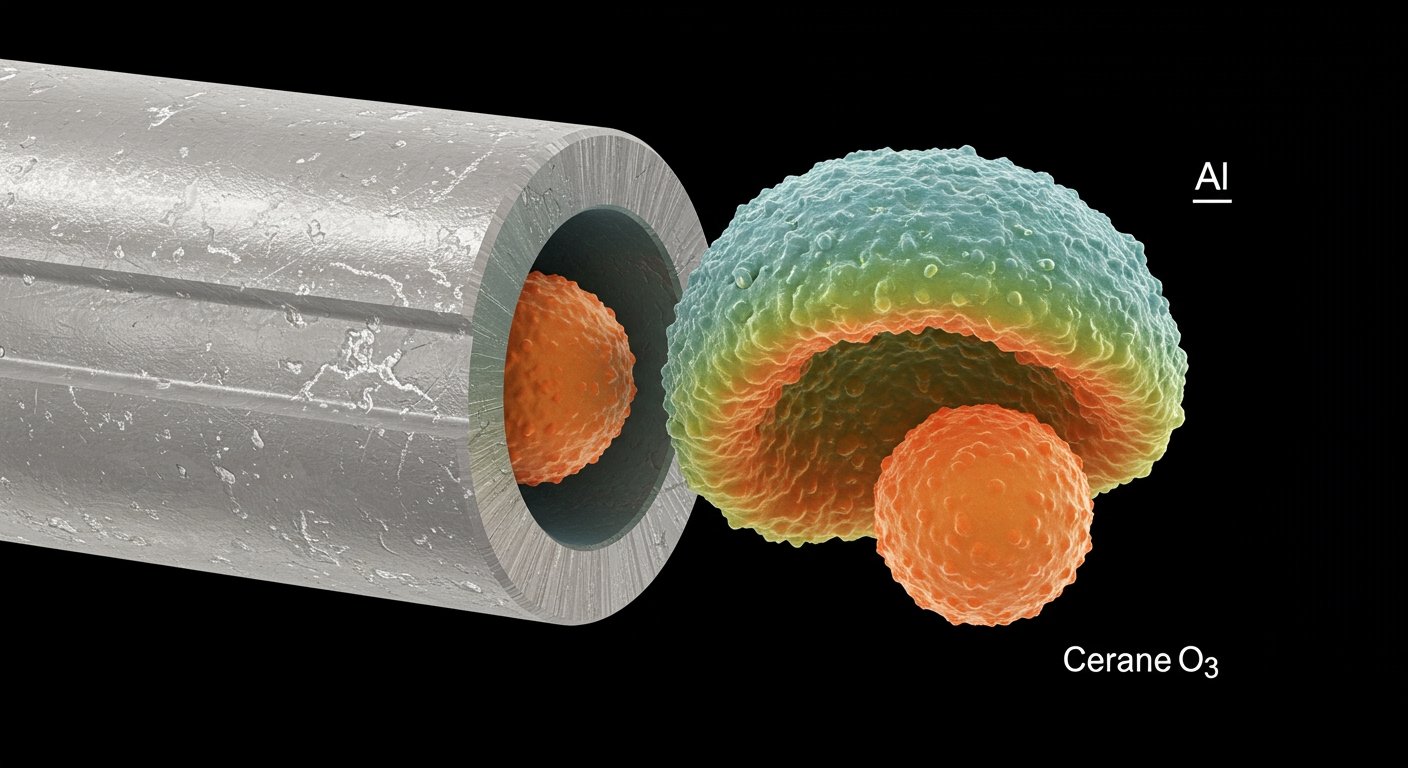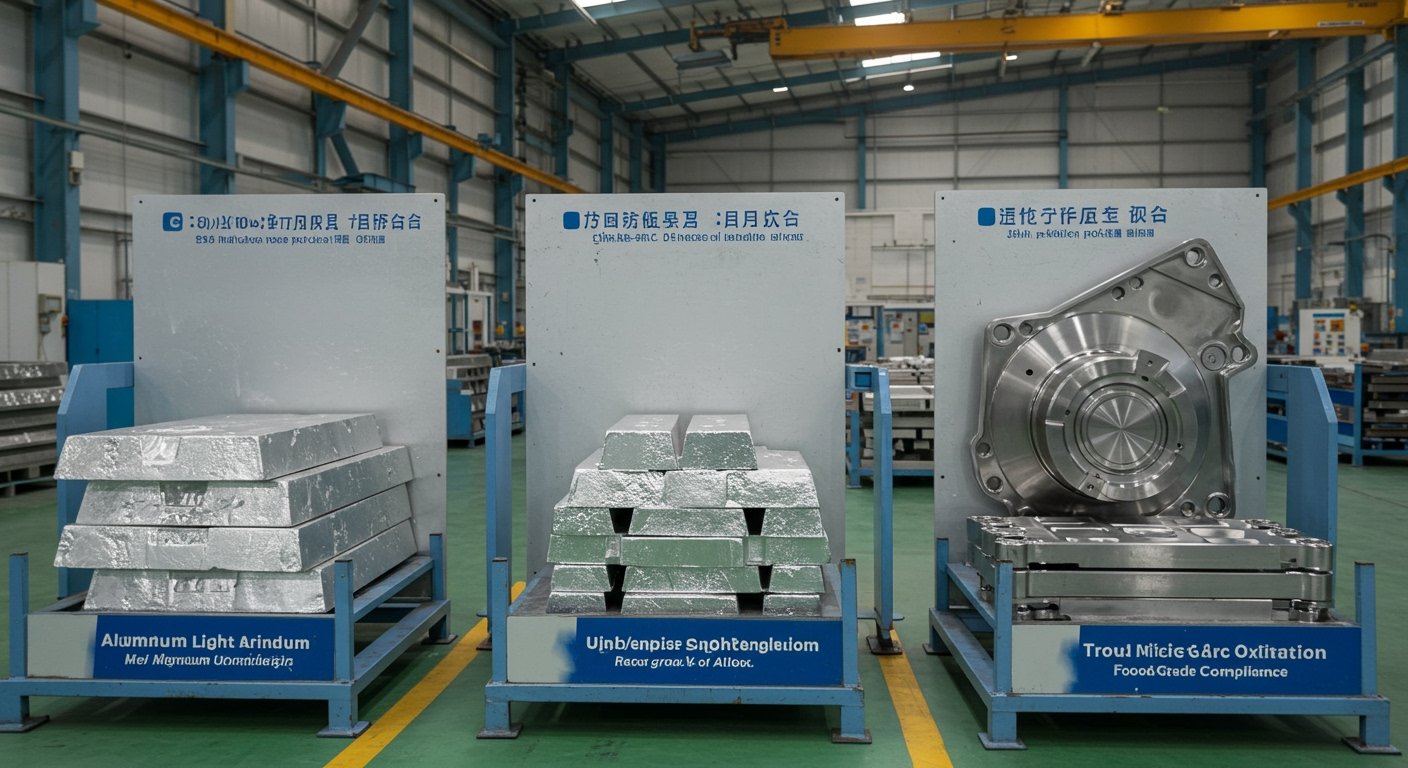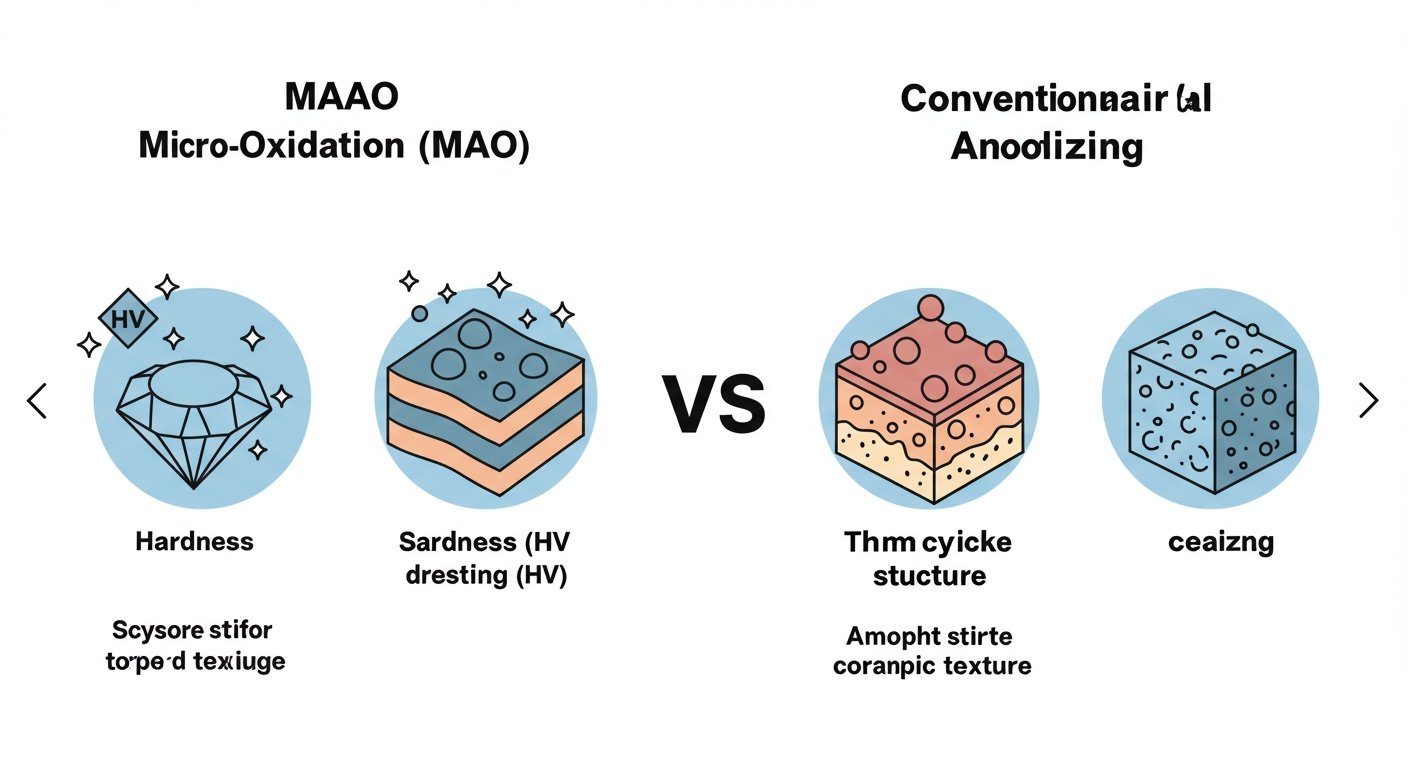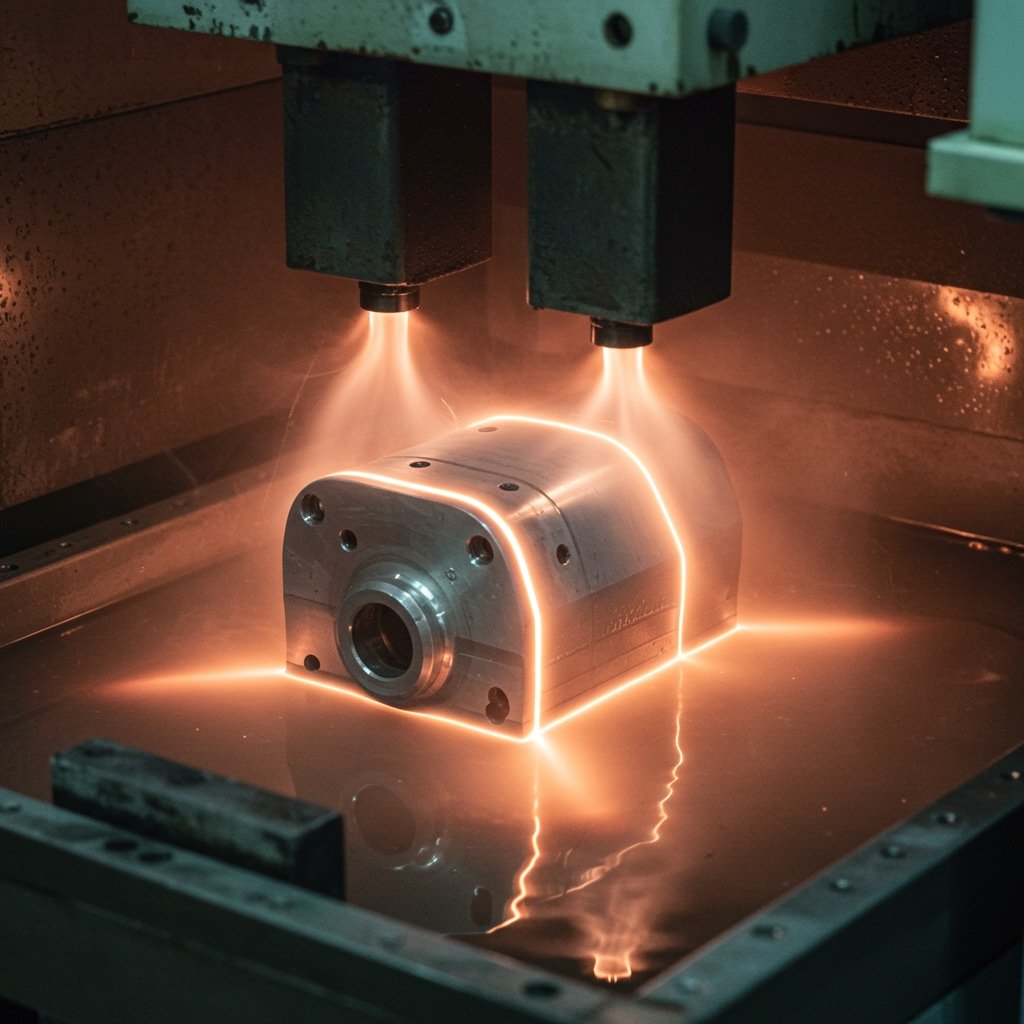Micro-arc oxidation (MAO) creates dense, hard, and chemically inert ceramic coatings on metals like aluminum, magnesium, and titanium. This process, when carefully controlled with non-toxic electrolytes, yields a highly stable surface that meets stringent food-grade standards. Unlike conventional anodizing, MAO layers exhibit superior wear and corrosion resistance, essential for demanding food contact applications where safety and durability are paramount for CNC machined parts.
Article Introduction
- Why Micro-Arc Oxidation Achieves Food-Grade Oxidation
- Colors Achievable with Micro-Arc Oxidation
- Materials Applicable for Micro-Arc Oxidation
- Micro-Arc Oxidation Process Parameters and Film Performance Optimization
- Micro-Arc Oxidation Multi-Functional Integration and Composite Films
- Functions, Advantages, Disadvantages, and Application Areas of Micro-Arc Oxidation
- Distinction Between Micro-Arc Oxidation and Anodizing
As a seasoned expert at ly-machining in Shenzhen, I have witnessed firsthand the evolving demands for surface treatments on metal components, especially in applications requiring stringent food-grade compliance. For “CNC machining” parts destined for the food and beverage industry, the choice of surface finish is critical, impacting not only performance but also safety and regulatory adherence. Our focus often turns to advanced solutions like “micro-arc oxidation” (MAO), a process that offers distinct advantages for achieving “food-grade oxidation”. This comprehensive guide shares our insights and practical experience.

Why Micro-Arc Oxidation Achieves Food-Grade Oxidation
When we consider “food-grade oxidation” for metal parts, the primary concern is the formation of a surface that is chemically inert, non-toxic, and robust enough to withstand continuous contact with food substances without leaching harmful elements. Micro-arc oxidation (MAO), also known as plasma electrolytic oxidation (PEO), addresses these challenges effectively. The process forms a ceramic-like coating directly from the base metal, primarily on light alloys such as aluminum, magnesium, and titanium.
#### The Intrinsic Safety of “Micro-Arc Oxidation” Coatings
The MAO process utilizes a specific electrolyte composition, typically aqueous solutions containing silicates, phosphates, or aluminates, free from heavy metals or toxic compounds. During treatment, micro-discharges on the metal surface transform the substrate into an extremely hard, dense, and adherent ceramic oxide layer. This layer is primarily composed of the oxides of the base metal (e.g., Al2O3 for aluminum), which are inherently stable and non-reactive.
Such an inert surface prevents the migration of metal ions into food products, crucial for maintaining product purity and safety. The robust nature of “micro-arc oxidation” also means the coating is highly durable, resisting wear and corrosion that could otherwise expose the underlying metal. This combination of inertness and durability makes MAO an excellent candidate for “food-grade oxidation” requirements.

Colors Achievable with Micro-Arc Oxidation
While “micro-arc oxidation” is primarily valued for its performance characteristics, the ability to produce a range of aesthetic colors can also be a significant advantage, particularly for parts requiring visual differentiation or branding. The color of an MAO coating is influenced by several factors, including the base material, the electrolyte composition, and the specific process parameters (voltage, current density, time).
#### Understanding “Micro-Arc Oxidation” Coloration
Typically, MAO coatings on aluminum can range from light gray to dark gray or even black. On titanium, colors like golden yellow, blue, or purple can sometimes be achieved due to interference effects within the film. Magnesium alloys often produce lighter, more uniform gray tones. Unlike anodizing, which often relies on dyeing, MAO colors are intrinsic to the oxide layer’s structure and composition.
Achieving consistent coloration, especially for “CNC machining” components where visual uniformity is important, requires precise control over the MAO process. We work closely with our clients to determine the feasibility of specific color requirements while maintaining the critical “food-grade oxidation” properties. Color stability over time and under various environmental conditions is also a key consideration.

Materials Applicable for Micro-Arc Oxidation
“Micro-arc oxidation” is highly effective on a specific group of light alloys, offering significant enhancements to their surface properties. These materials include aluminum, magnesium, and titanium alloys, which are commonly used in various industries, including those with “food-grade oxidation” requirements. Each material reacts differently to the MAO process, leading to unique coating characteristics.
#### Aluminum Alloys for “Micro-Arc Oxidation” and “Food-Grade Oxidation”
Aluminum and its alloys are perhaps the most common substrates for MAO due to their widespread use and the excellent properties conferred by the ceramic coating. The MAO process significantly boosts the hardness, wear resistance, and corrosion resistance of aluminum, making it suitable for demanding applications in food processing equipment. The resulting aluminum oxide layer is chemically stable and biocompatible.
#### Magnesium Alloys and “Micro-Arc Oxidation”
Magnesium alloys, known for their light weight, present challenges with corrosion resistance. “Micro-arc oxidation” offers a transformative solution, providing dense, protective ceramic coatings that drastically improve their corrosion performance. While less common for direct food contact than aluminum, MAO-treated magnesium components can be considered where specific design requirements demand the material’s lightness combined with enhanced surface protection.
#### Titanium Alloys in “Micro-Arc Oxidation”
Titanium and its alloys are inherently biocompatible and corrosion-resistant, making them ideal for medical and certain food contact applications. MAO further enhances these properties, creating even harder and more wear-resistant surfaces. For precision “CNC machining” titanium parts, “micro-arc oxidation” can extend lifespan and performance in critical environments. The coatings formed are highly stable and suitable for “food-grade oxidation” standards.

Micro-Arc Oxidation Process Parameters and Film Performance Optimization
The performance of a “micro-arc oxidation” coating is profoundly influenced by the precise control of its process parameters. To achieve optimal properties, particularly for “food-grade oxidation” applications, we meticulously adjust various factors. These include the applied voltage, current density, treatment time, electrolyte composition, and temperature.
#### Tuning Parameters for Enhanced “Micro-Arc Oxidation” Hardness
Higher voltages and current densities generally lead to thicker and harder MAO films. However, excessively aggressive parameters can result in rougher surfaces or even damage to the substrate. Balancing these factors is crucial for “CNC machining” parts where precise dimensional tolerances and surface finish are paramount. The electrolyte plays a significant role in dictating the film’s microstructure and hardness.
We use advanced diagnostic tools to monitor the process in real-time, ensuring consistent quality and performance. By fine-tuning the electrolyte chemistry, for instance, we can influence the incorporation of specific elements into the ceramic layer, further enhancing hardness and wear resistance without compromising the “food-grade oxidation” requirements.
#### Optimizing “Micro-Arc Oxidation” for Corrosion Resistance
Corrosion resistance is a cornerstone of “food-grade oxidation”, ensuring the longevity and safety of components in often aggressive food processing environments. The dense, barrier-like structure of MAO coatings provides excellent protection. Optimizing this involves achieving a uniform, pore-free layer with minimal micro-cracks.
Electrolyte composition, particularly the presence of silicates or phosphates, can significantly enhance the sealing effect of the MAO film, reducing porosity. Post-treatment sealing steps, although less common for MAO than conventional anodizing, can also be employed to further boost corrosion resistance. Our experience shows that well-optimized “micro-arc oxidation” offers superior corrosion protection compared to many other surface treatments.
Micro-Arc Oxidation Special Applications and Performance Research
Beyond conventional applications, “micro-arc oxidation” is continually explored for its unique properties in specialized fields. Our research and development efforts at ly-machining often delve into niche requirements, pushing the boundaries of what “micro-arc oxidation” can achieve, especially for advanced “food-grade oxidation” challenges.
#### “Micro-Arc Oxidation” in Challenging Food Environments
Consider parts exposed to highly acidic or alkaline cleaning agents in food processing. Standard surface treatments might degrade, but an optimized MAO layer maintains its integrity. We research specific electrolyte formulations that enhance chemical resistance against such aggressive media, ensuring long-term safety and performance. This is particularly relevant for “CNC machining” components that must endure rigorous sanitation protocols.
Another area is the prevention of microbial adhesion. While MAO coatings are inherently clean, some research explores incorporating antimicrobial agents into the film during or after the process. This could add an extra layer of protection, crucial for surfaces in constant contact with food, pushing the boundaries of “food-grade oxidation” standards.
Micro-Arc Oxidation Multi-Functional Integration and Composite Films
Modern industrial demands often call for surfaces with a combination of properties that a single treatment might not fully provide. This is where the concept of multi-functional integration and composite films in “micro-arc oxidation” becomes invaluable. We at ly-machining actively explore strategies to combine MAO with other surface treatments or integrate additional functionalities into the MAO layer itself.
#### Designing Composite Films for “Food-Grade Oxidation”
One approach involves creating multi-layered systems. For example, a primary “micro-arc oxidation” layer can provide exceptional hardness and corrosion resistance. A secondary, thin polymer layer could then be applied to add non-stick properties or enhanced chemical resistance without compromising the base MAO’s “food-grade oxidation” characteristics. This layered approach allows for a highly customized surface.
Another method is the incorporation of solid lubricants or nanoparticles directly into the MAO coating during its formation. This can create self-lubricating surfaces or further enhance wear resistance, beneficial for moving “CNC machining” parts in food machinery. The key is ensuring that any integrated materials maintain the overall food-grade compliance of the final surface.
Micro-Arc Oxidation’s Functions, Advantages, Disadvantages, and Application Areas
Micro-arc oxidation” is a versatile surface treatment with a distinct set of characteristics that make it suitable for numerous applications, especially where high performance and “food-grade oxidation” are required. Understanding its core attributes is essential for engineers and designers.
#### Core Functions and Advantages of “Micro-Arc Oxidation”
The primary function of MAO is to convert the surface of light alloys into a hard, dense, and wear-resistant ceramic layer. This significantly enhances the material’s intrinsic properties. Key advantages include:
- Exceptional hardness, often comparable to ceramics, far surpassing that of the base metal.
- Superior wear resistance, extending the lifespan of “CNC machining” components.
- Excellent corrosion resistance, protecting parts in aggressive environments.
- Good thermal insulation properties due to the ceramic nature of the coating.
- Strong adhesion to the base material because the coating grows from the substrate.
- Biocompatibility and inertness, making it ideal for “food-grade oxidation” and medical applications.
#### Limitations and “CNC Machining” Compatibility
While highly advantageous, “micro-arc oxidation” also has some limitations.
- The process is currently limited to specific light alloys (Al, Mg, Ti), not applicable to steels or copper.
- Achieving very thick coatings can sometimes lead to increased surface roughness.
- The initial capital cost for MAO equipment can be higher than for conventional anodizing.
Despite these, for critical “CNC machining” components, the benefits often outweigh the drawbacks.
#### Application Areas of “Micro-Arc Oxidation”
Beyond “food-grade oxidation” in processing and packaging equipment, MAO finds extensive use in:
- Aerospace and automotive industries for lightweight, high-strength components.
- Medical devices and implants due to its biocompatibility and wear resistance.
- Textile and electronics industries for improved durability.
- Sporting goods and consumer products requiring enhanced surface properties.

Micro-Arc Oxidation and Anodizing Distinction
Both “micro-arc oxidation” and conventional anodizing are electrochemical surface treatments for light alloys, primarily aluminum. However, they are fundamentally different processes that yield distinct coating characteristics, making the choice between them critical, especially for “food-grade oxidation” applications.
| Feature | Micro-Arc Oxidation (MAO) | Conventional Anodizing |
|---|---|---|
| Process Type | High voltage, plasma discharge | Low to medium voltage, electrochemical |
| Coating Structure | Crystalline ceramic (e.g., Al2O3) with amorphous regions | Amorphous oxide (e.g., Al2O3) with columnar pores |
| Film Thickness | Typically 10-100 µm (can be thicker) | Typically 5-25 µm (Type II), up to 50 µm (Type III) |
| Hardness (HV) | 800-2000+ | 200-500 |
| Wear Resistance | Excellent | Good (Type III), Fair (Type II) |
| Corrosion Resist. | Excellent | Good to Excellent (with sealing) |
| Substrate Impact | Forms from and into the substrate, highly adherent | Forms on the substrate |
| Pore Structure | Relatively dense, few open pores (self-sealing) | Porous structure, often requires sealing |
| Material Range | Al, Mg, Ti alloys | Primarily Al alloys |
| “Food-Grade Oxidation” Suitability | High, due to inert, dense ceramic | Good, with appropriate sealing and dye choices |
#### Structural and Performance Differences Impacting “Food-Grade Oxidation”
The high voltage and plasma discharges in “micro-arc oxidation” lead to the formation of a much harder, denser, and often thicker ceramic layer compared to the softer, porous amorphous oxide formed by conventional anodizing. This translates directly to superior wear and corrosion resistance for MAO. For “CNC machining” parts requiring extreme durability and chemical inertness in food contact, MAO often provides a more robust “food-grade oxidation” solution.
While anodizing can also meet “food-grade oxidation” standards, particularly with hard coat (Type III) and proper sealing, the inherent hardness and density of MAO coatings often give them an edge in highly demanding, abrasive, or corrosive environments. We consider the specific operational conditions when recommending the optimal surface treatment for our clients’ “CNC machining” components.
Micro-Arc Oxidation and Teflon Distinction
Comparing “micro-arc oxidation” (MAO) to Teflon (PTFE) involves looking at two entirely different classes of surface treatments—a ceramic conversion coating versus an organic polymer coating. Both can offer beneficial properties, but their functionalities and “food-grade oxidation” applications diverge significantly.
| Feature | Micro-Arc Oxidation (MAO) | Teflon (PTFE Coating) |
|---|---|---|
| Material Class | Ceramic (inorganic oxide) | Polymer (organic fluoropolymer) |
| Hardness | Extremely High (800-2000+ HV) | Low (typically 50-70 HV) |
| Wear Resistance | Excellent | Moderate (can be scratched) |
| Corrosion Resist. | Excellent | Excellent |
| Non-Stick Prop. | Moderate to Low (inherently hydrophilic) | Excellent (hydrophobic) |
| Operating Temp. | Very High (up to base metal melting point) | Limited (max ~260°C continuous) |
| Adhesion | Strong (grows from substrate) | Depends on surface prep, can delaminate |
| “Food-Grade Oxidation” Suitability | High (inert ceramic) | High (FDA approved grades available) |
| Primary Benefit | Hardness, wear, corrosion, bio-inertness | Non-stick, low friction, chemical resistance |
#### Material Characteristics and “Food-Grade Oxidation” Application Scenarios
“Micro-arc oxidation” creates a hard, durable ceramic layer that is integral to the metal substrate. This makes it ideal for components needing extreme wear resistance, protection against abrasion, and a chemically inert surface for “food-grade oxidation”. Examples include structural parts in food processing machinery, internal components of pumps, or surfaces where cleanliness and longevity are paramount without requiring non-stick properties. These are often “CNC machining” parts designed for high-stress environments.
Teflon, on the other hand, is a soft polymer primarily chosen for its exceptional non-stick properties and low friction coefficient. It’s perfect for cooking surfaces, molds, or any application where food release is critical. While Teflon coatings are “food-grade” certified, they lack the hardness and wear resistance of MAO. They are prone to scratching and can degrade at very high temperatures. Therefore, the choice between MAO and Teflon depends entirely on the specific performance requirements of the “CNC machining” part in its “food-grade oxidation” context. We guide our clients in selecting the most appropriate solution based on their detailed application needs.
In conclusion, for manufacturers demanding exceptional performance and “food-grade oxidation” compliance for their metal components, “micro-arc oxidation” stands out as a superior surface treatment. Its ability to create hard, wear-resistant, and chemically inert ceramic coatings on “CNC machining” parts of aluminum, magnesium, and titanium alloys offers unparalleled durability and safety. At ly-machining in Shenzhen, we leverage our deep expertise to tailor MAO solutions, ensuring your products meet the most stringent industry standards and perform optimally in their intended environments.
Related Questions / FAQ
#### 1. What are the key advantages of using “micro-arc oxidation” for “food-grade oxidation” over traditional methods like electroplating or organic coatings?
“Micro-arc oxidation” offers superior advantages due to the nature of its coating. Unlike electroplating, which applies a foreign metal layer that can delaminate or leach, MAO transforms the base metal into a ceramic oxide layer that is integral to the substrate. This ensures exceptional adhesion and prevents flaking. Compared to organic coatings, MAO provides significantly higher hardness and wear resistance, making it much more durable against abrasion and impact in demanding food processing environments. Furthermore, MAO coatings are inherently inert and do not contain organic compounds that could degrade or migrate, thus offering a more stable and safe “food-grade oxidation” solution.
#### 2. Can “micro-arc oxidation” coatings be applied to “CNC machining” parts with complex geometries or internal surfaces?
Yes, “micro-arc oxidation” is highly effective on “CNC machining” parts with complex geometries and internal surfaces. As an electrochemical process, the electrolyte solution can reach intricate shapes and internal channels, allowing for uniform coating formation across the entire wetted surface. Unlike line-of-sight coating methods, MAO does not suffer from shadowing effects. This capability is particularly beneficial for complex “CNC machining” components used in food processing equipment, where consistent “food-grade oxidation” on all surfaces is critical for hygiene and performance.
#### 3. How do we ensure the “food-grade oxidation” compliance of “micro-arc oxidation” coatings at ly-machining?
At ly-machining, ensuring “food-grade oxidation” compliance for our “micro-arc oxidation” coatings involves a rigorous, multi-faceted approach. First, we strictly control the electrolyte composition, using only non-toxic, food-safe components. Second, our process parameters are meticulously optimized to create a dense, defect-free, and inert ceramic layer. Third, we implement strict quality control measures, including visual inspections, coating thickness measurements, and adhesion tests. Finally, for specific client requirements, we facilitate independent third-party testing to verify compliance with relevant food contact material regulations (e.g., FDA, EU regulations) through leach testing and material analysis, providing our clients with peace of mind regarding the safety and suitability of their “CNC machining” components.

